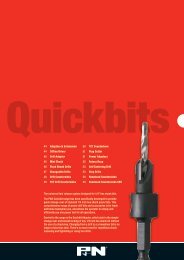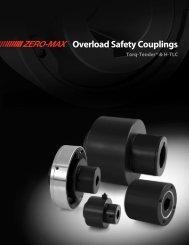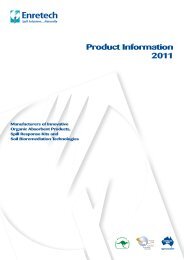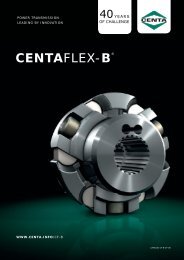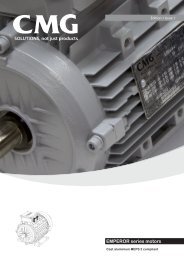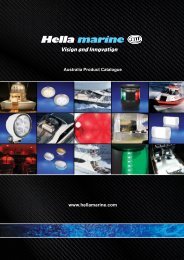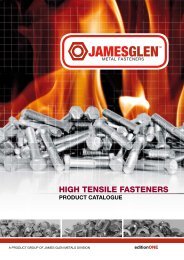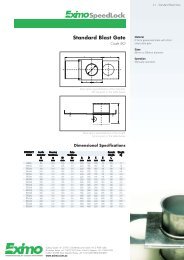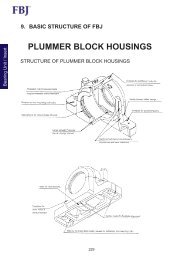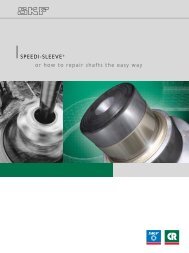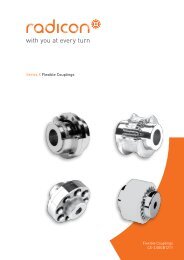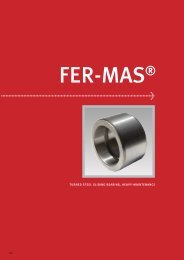Socket Products Engineering Guide - Industrial and Bearing Supplies
Socket Products Engineering Guide - Industrial and Bearing Supplies
Socket Products Engineering Guide - Industrial and Bearing Supplies
- No tags were found...
You also want an ePaper? Increase the reach of your titles
YUMPU automatically turns print PDFs into web optimized ePapers that Google loves.
Electroplating: Two broad classes of protectiveelectroplating are: 1. The barrier type-such as chromeplating-which sets up an impervious layer or film that ismore noble <strong>and</strong> therefore more corrosion resistant thanthe base metal. 2. The sacrificial type, zinc for example,where the metal of the coating is less noble than thebase metal of the fastener. This kind of plating corrodessacrificially <strong>and</strong> protects the fastener.Noble-metal coatings are generally not suitable forthreaded fasteners-especially where a close-tolerance fitis involved. To be effective, a noble-metal coating mustbe at least 0.001 in. thick. Because of screw-thread geometry,however, such plating thickness will usually exceedthe tolerance allowances on many classes of fit forscrews.Because of dimensional necessity, threaded fastenercoatings, since they operate on a different principle, areeffective in layers as thin as 0.0001 to 0.0002 in.The most widely used sacrificial platings for threadedfasteners are cadmium, zinc, <strong>and</strong> tin. Frequently, thecadmium <strong>and</strong> zinc are rendered even more corrosionresistant by a post-plating chromate-type conversiontreatment. Cadmium plating can be used at temperaturesto 450°F. Above this limit, a nickel cadmium or nickel-zincalloy plating is recommended. This consists of alternatedeposits of the two metals which are heat-diffused into auniform alloy coating that can be used for applications to900°F. The alloy may also be deposited directly from theplating bath.Fastener materials for use in the 900 to 1200°Frange (stainless steel, A-286), <strong>and</strong> in the 1200° to 1800°Frange (high-nickel-base super alloys) are highly corrosionresistant <strong>and</strong> normally do not require protective coatings,except under special environment conditions.Silver plating is frequently used in the higher temperatureranges for lubrication to prevent galling <strong>and</strong>seizing, particularly on stainless steel. This plating cancause a galvanic corrosion problem, however, becauseof the high nobility of the silver.Hydrogen Embrittlement: A serious problem, knownas hydrogen embrittlement, can develop in plated alloysteel fasteners. Hydrogen generated during plating c<strong>and</strong>iffuse into the steel <strong>and</strong> embrittle the bolt. The result isoften a delayed <strong>and</strong> total mechanical failure, at tensilelevels far below the theoretical strength, high-hardnessstructural parts are particularly susceptible to this condition.The problem can be controlled by careful selectionof plating formulation, proper plating procedure, <strong>and</strong>sufficient baking to drive off any residual hydrogen.Another form of hydrogen embrittlement, which ismore difficult to control, may occur after installation.Since electrolytic cell action liberates hydrogen at thecathode, it is possible for either galvanic or concentration-cellcorrosion to lead to embrittling of the boltmaterial.Joint DesignCertain precautions <strong>and</strong> design procedures can befollowed to prevent, or at least minimize, each of thevarious types of corrosion likely to attack a threadedjoint. The most important of these are:For Direct Attack: Choose the right corrosionresistantmaterial. Usually a material can be found thatwill provide the needed corrosion resistance withoutsacrifice of other important design requirements. Besure that the fastener material is compatible with thematerials being joined.Corrosion resistance can be increased by using aconversion coating such as black oxide or a phosphatebasetreatment. Alternatively, a sacrificial coating suchas zinc plating is effective.For an inexpensive protective coating, lacquer orpaint can be used where conditions permit.For Galvanic Corrosion: If the condition is severe,electrically insulate the bolt <strong>and</strong> joint from each other..The fastener may be painted with zinc chromateprimer prior to installation, or the entire joint can becoated with lacquer or paint.Another protective measure is to use a bolt that iscathodic to the joint material <strong>and</strong> close to it in the galvanicseries. When the joint material is anodic, corrosion willspread over the greater area of the fastened materials.Conversely, if the bolt is anodic, galvanic action is mostsevere.CopperSteelSteelInsulationwasherInsulationgasketFIG. 1.1 – A method of electrically insulating a boltedjoint to prevent galvanic corrosion.For Concentration-Cell Corrosion: Keep surfacessmooth <strong>and</strong> minimize or eliminate lap joints, crevices,<strong>and</strong> seams. Surfaces should be clean <strong>and</strong> free of organicmaterial <strong>and</strong> dirt. Air trapped under a speck of dirt on thesurface of the metal may form an oxygen concentrationcell <strong>and</strong> start pitting.For maximum protection, bolts <strong>and</strong> nuts should havesmooth surfaces, especially in the seating areas. Flushheadbolts should be used where possible. Further,joints can be sealed with paint or other sealant material.For Fretting Corrosion: Apply a lubricant (usually oil)to mating surfaces. Where fretting corrosion is likely tooccur: 1. Specify materials of maximum practicable hardness.2. Use fasteners that have residual compressivestresses on the surfaces that may be under attack. 3.Specify maximum preload in the joint. A higher clampingforce results in a more rigid joint with less relative movementpossible between mating services.72



